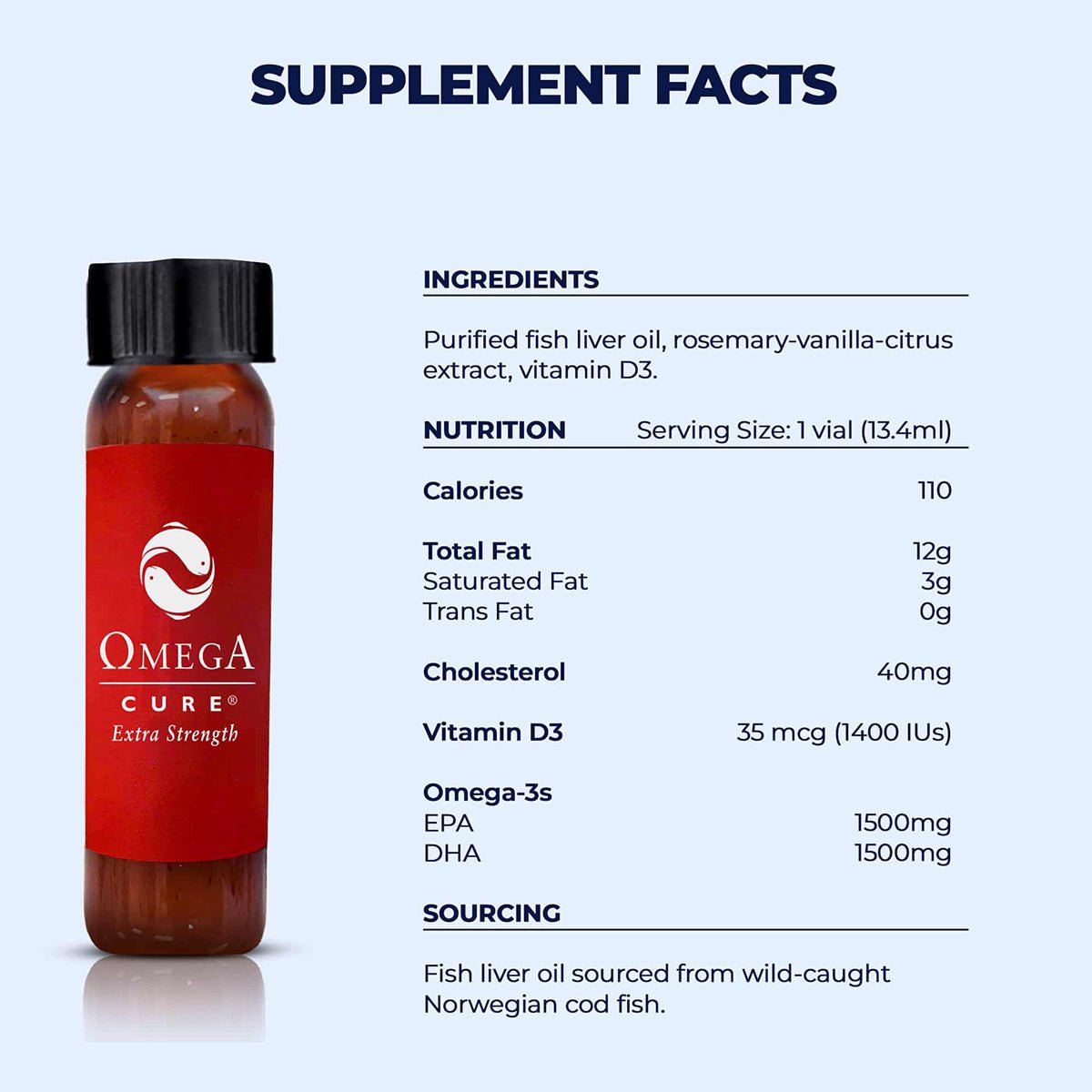Omega Cure Extra Strength Fresh Liquid Omega (7 Vials, 1 Week Supply) Cold Shipping Included
Omega Cure Extra Strength Fresh Liquid Omega (7 Vials, 1-Week Supply) – Cold Shipping Included
Ultra-Fresh Cod Liver Oil for Maximum Omega-3 & Vitamin D3 Absorption
Omega Cure Extra Strength is a pure liquid omega-3 supplement designed for individuals who want high-potency EPA/DHA without taking multiple capsules. Each single-serve vial provides 3000 mg of EPA/DHA and 1400 IU of Vitamin D3, offering a powerful blend to support heart, brain, eye, and immune health. Unlike traditional fish oils, Omega Cure is made from ultra-fresh cod liver oil, ensuring zero fishy taste or smell and superior absorption.
This 7-vial pack provides a convenient 1-week supply, making it ideal for travel, sampling, or starting your omega-3 routine.
Key Benefits:
- High-Potency Formula – Each vial delivers 3000 mg of EPA/DHA, providing robust omega-3 support.
- Includes Vitamin D3 – Contains 1400 IU of Vitamin D3 to aid bone, immune, and cardiovascular health.
- Ultra-Fresh, No Fishy Taste – Processed with near zero oxidation, ensuring a smooth, neutral flavor.
- Supports Brain, Eye & Heart Health – Helps reduce inflammation, enhances cognitive function, and supports vision and cardiovascular wellness.
- Liquid Form for Better Absorption – More bioavailable than capsules for maximum effectiveness.
- No Artificial Additives or Fillers – Pure, full-spectrum cod liver oil with no preservatives or unnecessary processing.
- Cold-Shipped for Freshness – Delivered in temperature-controlled packaging for optimal potency.
Why Choose Omega Cure Extra Strength?
Many omega-3 supplements suffer from oxidation, poor processing, and a fishy aftertaste. Omega Cure is different due to:
- Minimal Oxidation – Industry-leading low peroxide values (0.1 - 0.5 mEq/kg at bottling), compared to most fish oils that degrade before expiration.
- Sustainably Sourced – Made from wild-caught Norwegian cod, ensuring premium purity from sea to bottle.
- Gentle Cold Processing – Preserves full-spectrum omega-3s without exposure to high heat.
- No Capsules, No Rancidity – Liquid form preserves bioavailability and taste, unlike softgels that can degrade over time.
- Glass Vials for Protection – Packaged in oxygen-barrier glass vials, ensuring maximum potency from first to last dose.
Recommended Use:
- Take 1 vial daily with a meal for optimal absorption.
-
Shelf Life:
- 14 days at room temperature after opening.
- Refrigerate for up to 6 months for extended freshness.
How Omega Cure Stands Out from Traditional Fish Oils
Most omega-3 supplements come from sardines, anchovies, and mackerel, often subjected to harsh boiling and oxidation-prone processing, which diminishes their quality before reaching consumers.
Omega Cure, however, is extracted from premium Norwegian cod livers, which naturally store omega-3s in a low-oxidation environment. This results in a fresher, more effective product that retains its natural potency.
Why Liquid Omega-3 is Better than Capsules
- No Swallowing Difficulties – One vial provides the full daily dose, eliminating the need for multiple pills.
- Better Absorption – Liquid omega-3s are more bioavailable and easier to digest.
- No Capsule Oxidation – Unlike softgels, which may degrade over time, Omega Cure is fresh and stable.
Try Omega Cure Extra Strength Today!
This 7-vial pack is perfect for those looking for a short-term supply, a travel-friendly option, or an easy way to start incorporating omega-3s into their routine.
Order now and experience the difference of ultra-fresh omega-3 with Omega Cure Extra Strength!
Need Help? Just Ask
Our team is here to answer questions and guide you to the right products.
CONTACT USFind Dry Eye Doctors Near You
Connect with local, trusted dry eye specialists in your area.
VIEW DOCTOR LOCATOR











